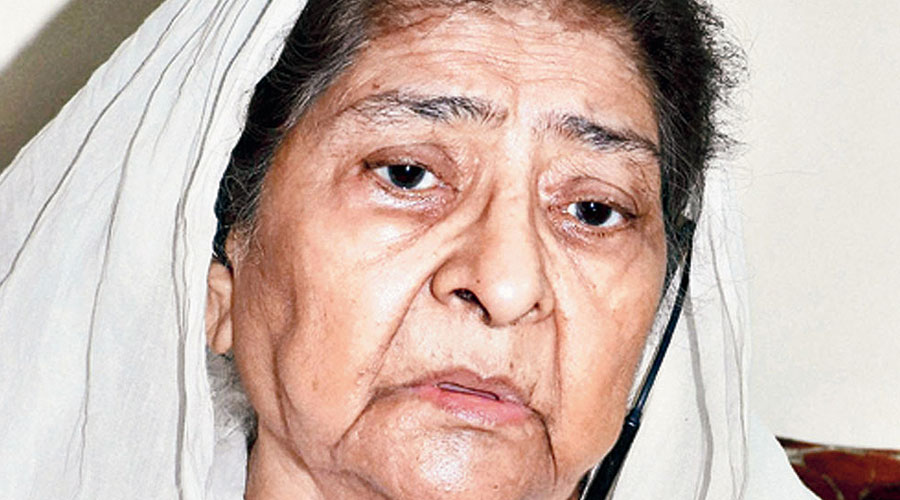The alleged conspiracy behind the 2002 Gujarat pogrom started playing out when the charred bodies of the kar sevaks killed in the Godhra train fire began to be paraded to Ahmedabad, the wife of a riot victim told the Supreme Court on Wednesday.
The apex court is hearing a plea from Zakia Jafri, whose husband and former Congress MP Ehsan Jafri was burnt alive with 68 others, challenging the clean chit given to then Gujarat chief minister Narendra Modi and others in the riots. The Citizens for Justice and Peace, an organisation that fights for constitutional rights of all Indians, is a co-petitioner in the case.
“Parading of the bodies (from Godhra to the Sola Civil Hospital in Ahmedabad) was also part of the conspiracy and there was no curfew declared in Ahmedabad till 12.45pm,” Zakia’s counsel Kapil Sibal said, resuming his arguments from last week.
“Photographs were taken of these bodies which created an atmosphere of revolt, revulsion and hatred. No one’s phone was seized. That is the best evidence possible,” he told the bench of Justices A.M. Khanwilkar, Dinesh Maheshwari and C.T. Ravikumar.
Sibal indicated the hand of higher-ups in the government and police.
“We say the conspiracy was hatched by Acharya Giriraj Kishore of the VHP who was escorted by police to the Sola Civil Hospital (where the bodies lay). Can your Lordships imagine a VHP functionary being escorted by police?” he said.
Ehsan and others were massacred in Ahmedabad’s Gulbarg Housing Society after the authorities allegedly ignored his pleas for help. An apex court-appointed special investigation team (SIT) probed Zakia’s riot conspiracy charges against Modi, other ministers and police bosses and absolved them in 2012.
The trial court accepted the SIT’s closure report in 2013 and Gujarat High Court upheld the decision in 2017, prompting Zakia to approach the Supreme Court.
“The question that has to be answered was (whether) the SIT (was) trying to protect the accused. It (probe) was set up by your Lordships,” Sibal said.
He made several points and allegations, such as:
# The Gujarat administration’s move of handing over the kar sevaks’ bodies to a VHP strongman should have been investigated. Under convention, bodies can be handed over only to relatives. “There was hasty disposal of the dead bodies of the Godhra victims. The post-mortem was done on the railway platform itself….”
# “They had ample intelligence inputs prior to the Sabarmati Express reaching Godhra. Had steps been taken as per police manual, perhaps this national tragedy could have been averted.”
# Over 3,000 RSS workers had gathered at the Sola Civil Hospital, yet no curfew was imposed. No explanation has come how such a large gathering was permitted.
# The state government delayed calling in the army, whose services were requisitioned only on March 1, 2002, and who reached Godhra on March 2. The Godhra fire had occurred on February 27 and the Gujarat-wide violence broken out on February 28.
# “Fifty-five people were released on bail when Dilip Trivedi (alleged VHP functionary) was appointed special public prosecutor. Should this matter be not investigated?... First you have VHP people calling for riots and then you appoint VHP people as prosecutors.”
# Instead of arresting key accused Babu Bajrangi, a state-level Bajrang Dal leader, the SIT recorded his statement and gave a clean chit to many accused.
# The SIT should have seized the mobiles of the accused, which it did not. Neither the judicial magistrate nor Gujarat High Court looked into these shortcomings.
# The SIT rejected the testimony of senior police officer R.B. Sreekumar — who had questioned the police role during the violence — on the ground that he had been denied a promotion (and bore a grudge) although several other police officers corroborated his account.
# Certain seized tapes suggested a conspiracy to smuggle explosives into Ahmedabad from a quarry owned by a VHP worker. The SIT did not probe this.
# The SIT did not challenge the high court judgment acquitting former minister Maya Kodnani, who had been convicted and jailed in the Naroda Patiya case in which 97 people were killed.
# To a query from Justice Khanwilkar on the SIT’s response to the Tehelka portal’s purported sting operation, which allegedly buttressed the charge of conspiracy, Sibal said the agency had rejected it as irrelevant since it contained extrajudicial confessions.
“In a case of conspiracy there won’t be direct evidence. It can only be inferred from circumstances for which you have to investigate, gather evidence, visit the spots and record the statement,” Sibal said. He said the SIT did none of this.
Sibal also made an emotional statement during the arguments, stressing the evils of sectarian violence and saying his family was a victim.
“Communal violence is like lava erupting from a volcano, be it by any community. It is an institutionalised problem. When the lava touches the ground… it scars and leaves the earth a fertile ground for future revenge,” he said.
“I lost my maternal grandparents to it in Pakistan. I am a victim of the same. I don’t want to accuse A or B. A message must be sent to the world that this cannot be tolerated.”
He added: “I am not on any high-ranking person who gave instructions or not. You can take this from me on record. This is a bigger picture if rule of law can prevail or can muck be allowed to run its course.”
The arguments will continue on Thursday.










